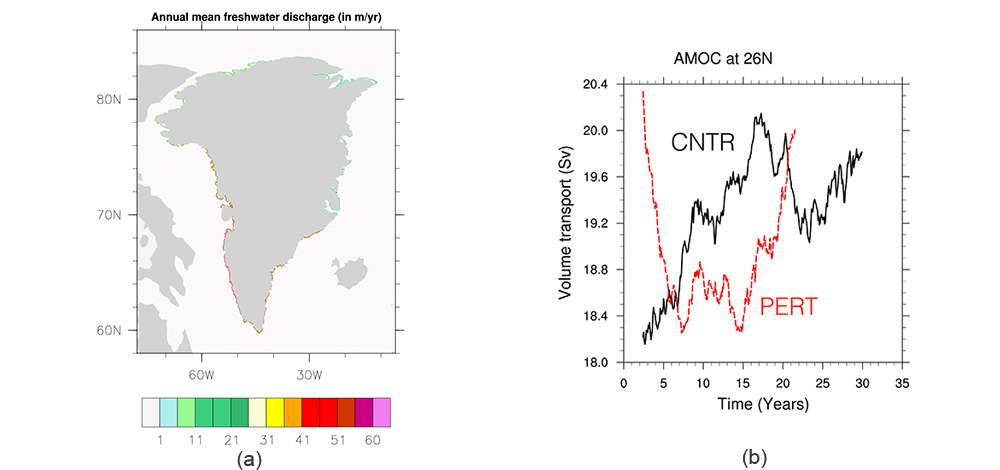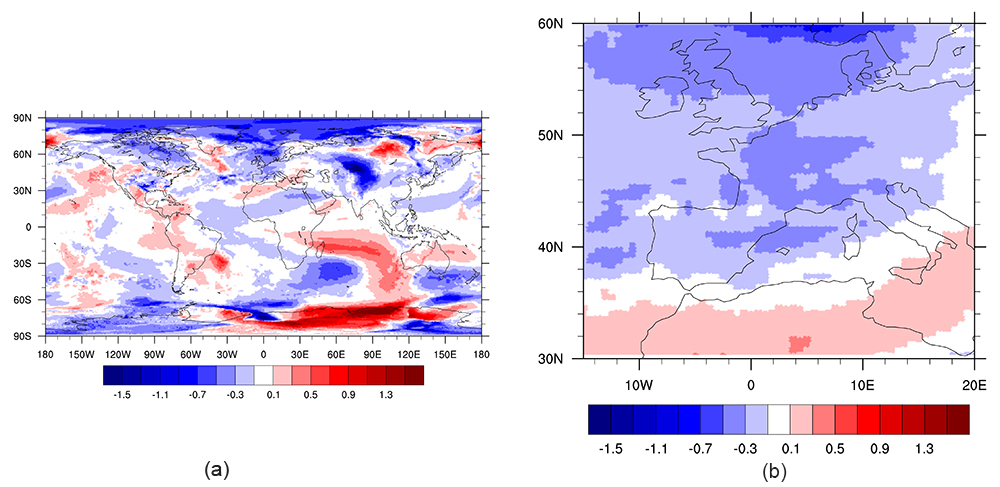ENVIRONMENT AND ENERGY
Response of the Atlantic Ocean Circulation to Greenland Ice Sheet Melting
Principal Investigator:
Henk A. Dijkstra
Affiliation:
Institute for Marine and Atmosphere Research Utrecht (IMAU), Utrecht University (The Netherlands)
Local Project ID:
PP13081679
HPC Platform used:
Hermit of HLRS
Date published:
Using the computing capabilities of HLRS system Hermit, a team of scientists used the Community Earth System Model (CESM) with a strongly eddying ocean submodel to study the presence of ocean eddies on the sensitivity of the Meridional Overturning Circulation (MOC) in the Atlantic Ocean to the Greenland Ice Sheet (GrIS) freshwater anomalies.
1 Scientific Challenge
The Meridional Overturning Circulation (MOC) in the Atlantic Ocean is considered an important component of climate, because of its large northward heat transport. There are strong indications from climate data of the geological past as well as from present-day climate model simulations that the MOC is sensitive to freshwater perturbations. Enhanced runoff due to melt of the Greenland Ice Sheet (GrIS) may lead to disruption of the MOC and hence to extreme climate changes in the North Atlantic region on a time scale of a few decades.
Climate models in which ocean eddies are only roughly represented have been used in the past to study the behavior of the MOC to GrIS meltwater anomalies. However, resolving ocean eddies is crucial for obtaining quantitatively correct ocean circulation patterns in the North Atlantic, in particular for a correct Gulf Stream path. In this project, which was made possible through the Partnership for Advanced Computing in Europe (PRACE), a team of scientists used the Community Earth System Model (CESM), with a strongly eddying ocean submodel to study the presence of ocean eddies on the sensitivity of the MOC to GrIS freshwater anomalies. Main questions addressed are the following:
- What are the spatial and temporal characteristics of the climate response to a severe reduction of the strength of the MOC? What changes in the mean value, typical variations, and extremes of temperature, wind, and precipitation can be expected in different areas around the globe, and in particular in Western Europe? How do these characteristics differ between the low- and high-resolution simulations?
- Is the sensitivity of the MOC to freshwater forcing different between an ocean-only simulation and a fully coupled climate model? Which feedbacks are important in the interaction between ocean, atmosphere, sea-ice and land? How do these feedbacks relate to the maintenance of the global heat budget? And how does the representation of these feedbacks differ between low- and high-resolution simulations?

Figure 1: (a) Freshwater forcing (in m/yr) along the Greenland Ice Sheet. (b) The response of the MOC in the CNTR and PERT simulation.
Copyright: IMAU, Department of Physics, Utrecht University2 Computational Effort
The administration of CESM is maintained by the U.S. National Center for Atmospheric Research (NCAR). The researchers used version 1.03 of the CESM which has a 0.47° x 0.63° horizontal grid (384 x 576 latitude/longitude grid) for the atmosphere and land component and a 0.1° degree horizontal grid (2400 x 3600 latitude/longitude grid) for the ocean and sea-ice component. With the available 22 M core hours on HPC system Hermit (HLRS), the scientists were eventually able to perform a 75 year control simulation (CNTR) under CO2 levels year 2000 and a 25 year GrIS freshwater perturbation simulation (PERT). This perturbation consists of about 0.06 Sv (0.1 Sv (Sverdrup) is about the volume transport of the Amazon river) and increases slightly in time as derived from projections of future GrIS melt. These two simulations provided about 100 TB of data, which was transported by GRIDftp from HLRS to SURFsara (Amsterdam) for further analysis.
3 Main Results
In Fig. 1a, the distribution of the GrIS freshwater flux is shown which is fed to the model at model year 50. In Fig. 1b, the behavior of the MOC for the CNTR and PERT simulations is shown by plotting the maximum MOC strength in the North Atlantic at 26°N. The MOC decreases after 10 years of the simulation but there is a strong variability and so the long-term response can only be determined by a longer simulation.

Figure 2: (a) Difference in atmospheric surface temperature (in °C) between the average of the years 14-23 of PERT minus 64-73 of CNTR. Note that PERT started after year 50 of CNTR. (b) Detail of the plot in (b) with a focus on Western Europe.
Copyright: IMAU, Department of Physics, Utrecht UniversityA plot of the decadal mean atmospheric surface temperature difference in the North Atlantic over the last 10 years is shown in Fig. 2a with a focus on Western Europe in Fig. 2b. This indicates that the decrease of the MOC due to GrIS meltwater can lead locally to 1°C decadal mean temperature changes over Western Europe. Another interesting finding is the appearance of multidecadal variability in the MOC in the CNTR simulation which is now also under investigation [1].
[1] Le Bars, D., Kliphuis, M. and H.A. Dijkstra, Interhemispheric modes of multidecadal variability in the oceanic heat content, in preparation for Nature Geoscience, (2015).
Scientific contact:
Dr. Prof. dr. ir. H.A. Dijkstra
Institute for Marine and Atmosphere Research Utrecht (IMAU)
Department of Physics and Astronomy
Utrecht University
Princetonplein 5, NL-3584 CC Utrecht/The Netherlands
e-mail: H.A.Dijkstra@uu.nl